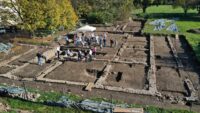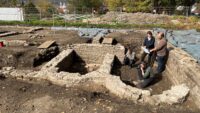 The remains of a 2,000-year-old luxury Roman villa have been discovered in Kempten, Bavaria. Located on the western end of the ancient city near the temple district, the most desirable part of town, the domus was large, at least 8,600 square feet over two stories. It had screed floors, frescoed walls and private hot baths complete with underfloor hypocaust heating.
The remains of a 2,000-year-old luxury Roman villa have been discovered in Kempten, Bavaria. Located on the western end of the ancient city near the temple district, the most desirable part of town, the domus was large, at least 8,600 square feet over two stories. It had screed floors, frescoed walls and private hot baths complete with underfloor hypocaust heating.
The most exciting thing about the finds for the archaeologists: They belonged to private stone houses. “You won’t find such private buildings in stone anywhere in southern Germany at this early time – at the beginning of the first century,” says Johannes Schiessl from the city archeology department of Kempten. That means: while elsewhere the Roman settlers still lived in wooden and clay buildings, the high society in Cambodunum apparently already resided in chic brick town houses.
What is today Kempten was founded as Cambodunum on the site of a Celtic settlement destroyed by the forces of Nero Claudius Drusus Germanicus (father of the Germanicus usually associated with that cognomen) and his brother Tiberius in 15 B.C. In the first decade of the new millennium, the city of Cambodunum was built according to the typical Roman grid plan with major public buildings including baths, temples and a forum. It was the administrative center of the region and the seat of the Roman governor of the Roman province of Raetia. Cambodunum remained the capital of the province until 120 A.D. when Augsburg, aka the Roman colony of Augusta Vindelicum, was given the role.
 Cambodunum is the oldest German city mentioned in writing, and the discovery of the luxury private domus underscores that the Romanization of Bavaria, the development of an urban culture mirroring Rome’s, began in Kempten. It also proves that the early city, which was believed to have been built largely out of wood, utilized high-quality stone and brick architecture for important civic structures and the homes of the wealthy.
Cambodunum is the oldest German city mentioned in writing, and the discovery of the luxury private domus underscores that the Romanization of Bavaria, the development of an urban culture mirroring Rome’s, began in Kempten. It also proves that the early city, which was believed to have been built largely out of wood, utilized high-quality stone and brick architecture for important civic structures and the homes of the wealthy.
The finds will be thoroughly documented and then reburied for their own protection. The ultimate goal, however, is to preserve the remains in situ for exhibition as part of the Cambodunum Archaeological Park, the largest Roman archaeological park in southern Germany and the only one with a Gallo-Roman temple complex that includes full-scale replicas of the ancient buildings.